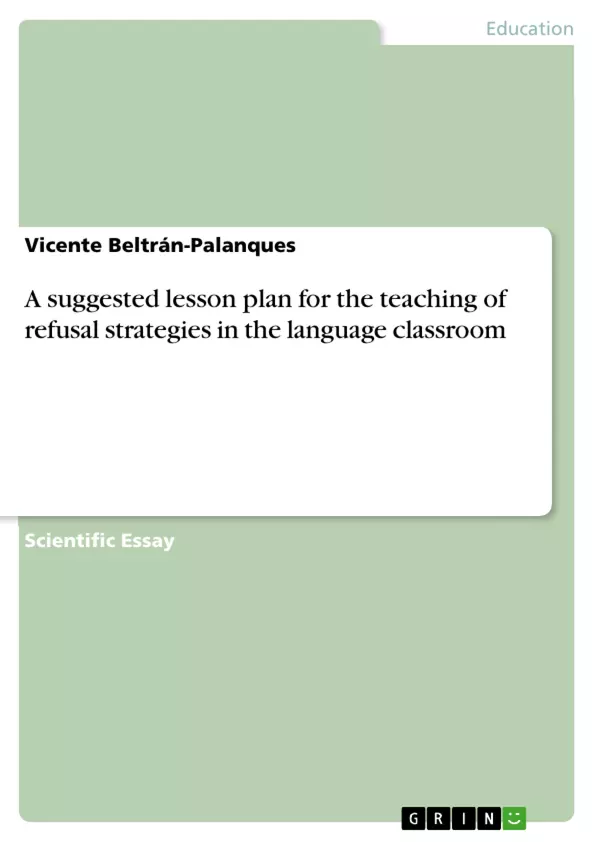Following the recommendations made by Farrell (2002) about how to elaborate appropriately a lesson plan, the aim of the present paper is that of presenting a sample of a lesson plan for the teaching of a particular speech act (i.e. refusals). The rationale behind this selection is based on the idea this type of speech act is seen as one of the most face-threatening acts, and consequently learners need to obtain a particular expertise to outperform them appropriately (Eslami, 2010). Audiovisual material (i.e. films) will be used for the elaboration of the activities within the lesson plan. We have selected this type of material since many authors have suggested that this type of material appears to be very beneficial for providing learners with contextualised examples of language (Alcón, 2005; Rylander, 2005; Martínez-Flor, 2007; Martínez-Flor & Usó-Juan, 2010; Beltrán-Palanques, 2011). The present paper is divided into three main parts: the first part will be deal with the main components of lesson plan, the second part will provide an overview of different type of materials that might be used for the teaching of language classroom, and finally, a sample of a daily lesson plan for the teaching of the speech act of refusals will be provided.
Inhaltsverzeichnis (Table of Contents)
- State of the art
- Structuring the language lesson
- Language materials and pragmatic competence
- A Suggested lesson plan for the teaching of refusals
- Conclusion
Zielsetzung und Themenschwerpunkte (Objectives and Key Themes)
This paper aims to provide a comprehensive lesson plan for the teaching of refusal strategies in the language classroom. The paper draws upon existing research and literature on language teaching, lesson planning, and the specific challenges of teaching refusals. The lesson plan is designed to be adaptable and applicable to various language learning contexts.
- The importance of lesson planning in language teaching
- The role of pragmatics and speech acts in language acquisition
- The challenges of teaching refusals as a face-threatening act
- The use of audiovisual materials in language teaching
- The development of a specific lesson plan for the teaching of refusals
Zusammenfassung der Kapitel (Chapter Summaries)
- State of the art: This chapter introduces the concept of lesson planning in language teaching, highlighting its importance and key components. It also explores different approaches to lesson planning, including the traditional instructional model and more learner-centered models. This section provides a framework for understanding the principles behind effective lesson design in language education.
- Structuring the language lesson: This chapter delves deeper into the process of structuring a language lesson. It examines various models for lesson planning, emphasizing the importance of setting clear objectives, selecting appropriate activities, and evaluating the effectiveness of the lesson. This chapter discusses the advantages and limitations of different approaches to lesson planning, guiding teachers towards a more nuanced and dynamic approach to lesson design.
- Language materials and pragmatic competence: This chapter focuses on the role of materials in language learning, particularly with regard to developing pragmatic competence. It explores the potential of various materials, including audiovisual materials, for teaching language learners how to effectively use different speech acts, including refusals. This section highlights the importance of selecting and using materials that promote real-world language use and communicative competence.
Schlüsselwörter (Keywords)
Key terms and concepts explored in this paper include lesson planning, language teaching, pragmatics, speech acts, refusal strategies, face-threatening acts, audiovisual materials, and communicative competence.
- Citar trabajo
- Ph.D. Student Vicente Beltrán-Palanques (Autor), 2013, A suggested lesson plan for the teaching of refusal strategies in the language classroom, Múnich, GRIN Verlag, https://www.grin.com/document/214173



